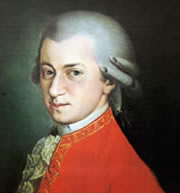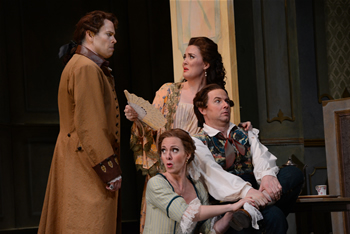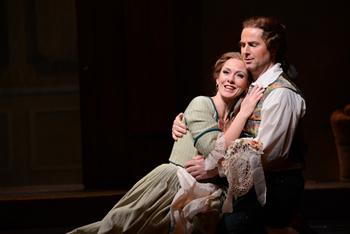Virginia Opera's Marriage of Figaro: True to Mozart and Da Ponte's Revolutionary Spirit
by Megan Beets
May 2013
 Wolfgang Amadeus Mozart. |
Review of The Marriage of Figaro
By Wolfgang Amadeus Mozart
Libretto by Lorenzo da Ponte
Virginia Opera
April 21, 2013
Music Director: Steven Smith
Stage Director: Lillian Groag
Cast:
Countess Almaviva • Katherine Whyte
Count Almaviva • Aaron St. Clair Nicholson
Susanna • Anne-Carolyn Bird
Figaro • Matthew Burns
Cherubino • Karin Mushegain
Doctor Bartolo • Jeffrey Tucker
Marcellina • Margaret Gawrysiak
Don Basilio • Drew Duncan
Don Curzio • Patrick O’Halloran
Antonio • Aaron Ingersoll
Barbarina • Ashley Logan

Courtesy of Virginia Opera. Photo by David A. Beloff
Clockwise from left: Aaron St. Clair Nicholson (Count Almaviva), Katherine Whyte (Countess Almaviva), Matthew Burns (Figaro) and Anne-Carolyn Bird (Susanna). |

Courtesy of Virginia Opera. Photo by David A. Beloff
Anne-Carolyn Bird (Susanna) and Matthew Burns (Figaro). |
The April 21st, 2013 performance by the Virginia Opera of Mozart's revolutionary opera, The Marriage of Figaro surpassed all expectation. The cast and director brought to the stage a gripping drama, woven by a well-crafted counterpoint of humor, tension and Mozart's incredible music, sung by a vibrant cast of beautiful voices. The production was coherent throughout, with each detail thoughtfully chosen to build toward the moving final scene.
The opera itself was written over a period of six weeks and was first performed May 1, 1786 in Vienna. Mozart himself chose the controversial libretto. Together with the librettist Lorenzo Da Ponte, who was exiled from Venice after openly promoting the ideas of the ongoing American Revolution, Mozart won over the Emperor Joseph II to defend and promote its production. Rather than a traditional opera buffa, Mozart and Da Ponte kept the elements of a comic opera in what unfolds as a higher, more developed form of stage drama (a la Shakespeare, whose works were then being translated into German), in which the music and dramatic action became one. Mozart and Da Ponte's close collaboration on turning Beaumarchais's comic play Le mariage de Figaro into a suitable libretto for Mozart's musical genius is just one example of the kind of individuals and circles that Mozart worked with during his 10 years in Vienna. Contrary to what is typically said about Figaro's political message being one of mere class warfare, with smart servants, and stupid aristocrats, Mozart and Da Ponte masterfully crafted the libretto to bring out a much more politically powerful idea, one central in the works of another republican revolutionary, Friedrich Schiller: that virtue, truth and compassion are more powerful than pure might. In Figaro, this idea emerges in the poignant moment of the final scene when the Count, forced to face his own humility by his faithful wife, kneels down to ask for forgiveness.
That Mozart would champion such an idea, coherent with the ongoing republican experiment in America, is no accident. Since the moment of his arrival in Vienna, he was brought into the salons of Countess Thun, where he met the leading republicans in Vienna, and of the Baron van Swieten, where he intensely studied the works of J.S. Bach. However, even aside from the circles of individuals who influenced him, his own musical genius shows us a mind which is gripped by the coherence of beauty and truth, and which therefore naturally gravitated toward the pursuit of the highest political freedom for mankind.
The Virignia Opera production masterfully balanced moments of well-timed, and appropriately over-the-top humor (the Count jealously bursting into the Countess's chamber wielding a huge medieval axe in order to break into a closet) with quieter moments of tenderness between the couples, and the tension of an unfolding, precarious plot to catch the Count. Even seemingly insignificant or arbitrary choices of the director, such as the constant presence of servants other than Susanna and Figaro scurrying about the household, often absent from other productions, and the hilarious crowd eavesdropping at the door of the Countess's chamber as she quarrels with her jealous husband, were deliberate, crucial elements of a tightly-woven, rich backdrop against which the dramatic action among the principal characters could unfold.

Courtesy of Virginia Opera. Photo by David A. Beloff
|
The production made a powerful use of silence, pauses in both the music and dramatic action. Most notable was the absolute hush that came over the stage in the final scene, as the Countess, beautifully attired, slowly walks out onto the stage to confront her jealous husband, who believes to have just caught her cheating on him with Figaro. The tense silence is finally broken by gasps from the onlookers as the Count, humiliated, kneels down to ask his wife for forgiveness. Katherine Whyte played an excellent Countess. Her moving performance of Dove Sono perfectly set up the beautifully-crafted final scene, in which the Countess's earlier hope that her love and faithfulness could change her arrogant husband is realized. Even one or two minor distractions (Madame Defarge as one of the village girls?) couldn't mar the excellent production. Its success did absolute justice to Mozart and Da Ponte's genius, and succeeded in showing the audience that the universal qualities of virtue, love and beauty are more powerful the might of any aristocracy.
